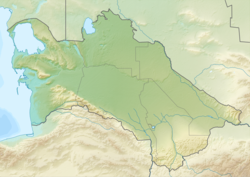| Danata Formation | |
|---|---|
| Stratigraphic range: Early Eocene-Mid Eocene ~ | |
| Type | Geological formation |
| Location | |
| Coordinates | 38°38′N 55°48′E / 38.633°N 55.800°E[1] |
| Approximate paleocoordinates | 35°06′N 51°12′E / 35.1°N 51.2°E |
| Country | |
The Danata Formation (or Danatinskaya, Danatinsk, Russian: Danata Svita) is an earliest Eocene to Middle Eocene sedimentary succession located in Turkmenistan. It is mostly famous for its fish-bearing horizons (Ichthyofauna).[1] The formation for example crops out in the Kopet Dag mountain range in the border region of Turkmenistan and Iran.[1] It was deposited in a far northeastern arm of the Tethys Sea.[2]
Previously, it was thought that the earliest horizons of this formation dated to the latest Paleocene (Thanetian). However, more recent studies have found the formation's sapropel to originate from a global anoxic event caused by the Paleocene-Eocene Thermal Maximum, indicating that it formed just after the Paleocene-Eocene boundary, during the earliest Ypresian.[2]
- ^ a b c Prokofiev, Artém M. "The Late Paleocene fish fauna of Turkmenistan" (PDF). Archived from the original (PDF) on 15 March 2016. Retrieved 15 November 2013.
- ^ a b Bannikov, A. F.; Erebakan, I. G. (2023-10-01). "On the Evolution of Some Groups of Marine Bony Fishes in the Cenozoic of the Tethys and Paratethys". Paleontological Journal. 57 (5): 475–490. Bibcode:2023PalJ...57..475B. doi:10.1134/S0031030123050015. ISSN 1555-6174.
